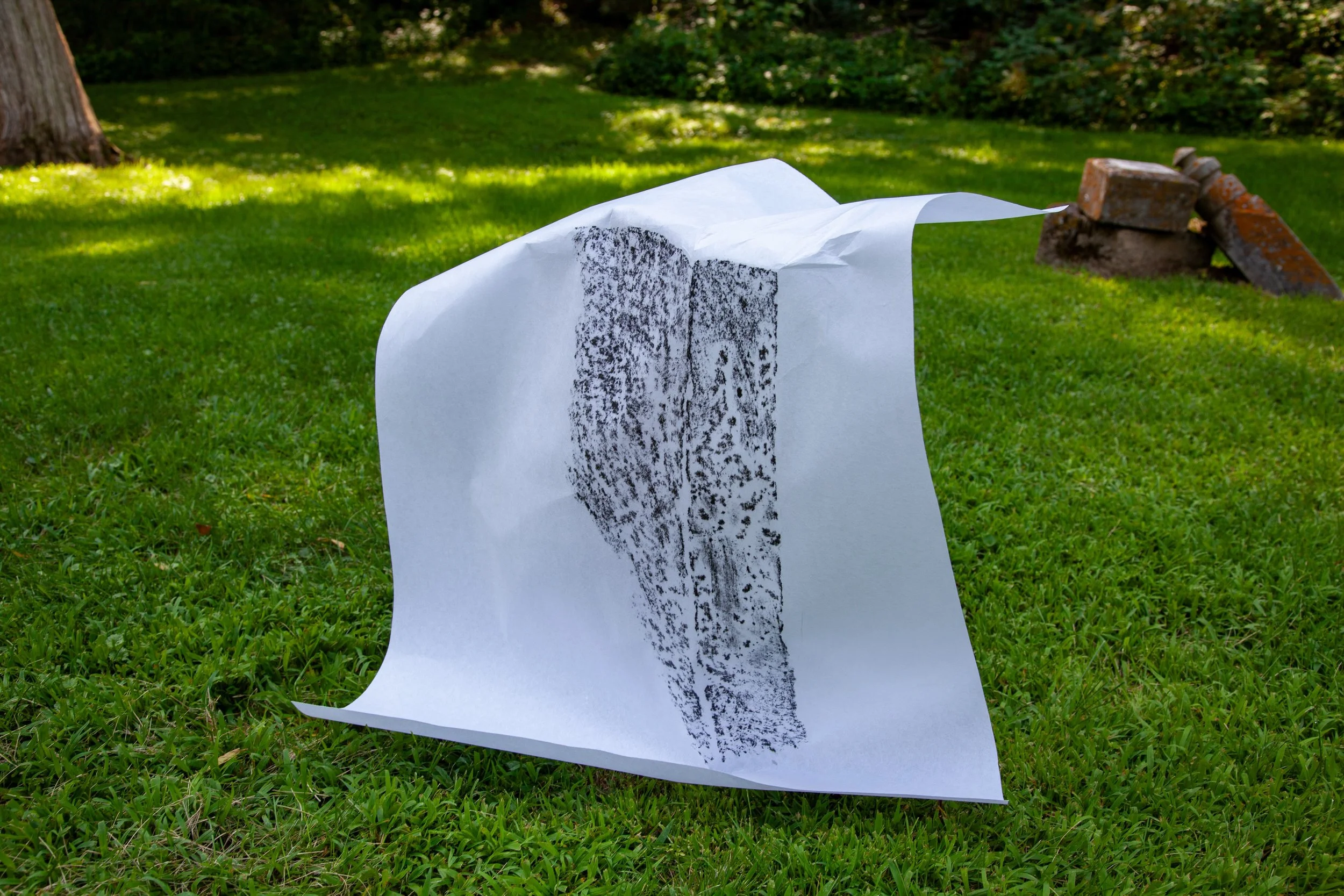Photo by John Niekrasz
From October 3-29, 2025, New City Arts presents Perpetual Care, an exhibition by Elena Yu.
Exhibition Events
Gravestones & the Abundance of Life | 10/17 | 6-7:30PM | A presentation & conversation with Elena Yu & Judy Jacob (Retired NPS Senior Conservator) on gravestones, lichens, microorganisms, & the complexities of cemetery preservation.
Thank You
This exhibition is supported by Lisa M. Draine.
New City Arts' Welcome Gallery
114 3rd St. NE, Charlottesville, VA 22902
First Friday Opening Reception
October 3 from 5-7:30PM; Artist talk at 6PM. Free and open to the public. All ages welcome. Exhibition opening sponsored by William Taylor and the Taylor Group of Truist Investment Services.
Gallery Hours
Wednesday-Saturday from 10AM-5PM
Exhibition Statement (courtesy of the artist)
Perpetual Care looks closely through a loupe at lichens living on cemetery stones and considers how interspecies knowledge, respect and tending might enable new ways of interacting with sites of human memorialization. Lichens are complex life forms made up of symbiotic relationships between two organisms; fungi and algae or cyanobacteria. Each partner gains abilities by coming into relationship with the other, forming mutualistic, enduring bonds.
I am visiting my maternal ancestors in a cemetery in Masterton, New Zealand. I am absorbed by lush lichen growing on all sides of many gravestones. Lichen grows in the engraved letters on the front of stones, and completely covers the unpolished backs of stones with sage green foliose florets. In the engravings, crustose and foliose lichens find friendly, shaded, moist homes. Do these lichens know they are spelling out the names of bodies below, articulating and sometimes obscuring them for the cemetery’s human visitors? My 90-year-old great aunt comments that when she comes to this cemetery, she cleans the lichens off of our family members’ stones. Cleaning is how she cares for her parents’ memory.
Lichens thrive in cemeteries, where well over 100 different species of lichen can be found in a single cemetery. But they often go unseen and unnamed by the average person, despite their vibrant shapes and colors and the fact that there are about 18,000 known species of lichens, more than the number of known species of birds. Lichens on gravestones are often described as dirt and seen as representative of decay or abandonment. However, lichens do not definitively contribute to the deterioration of gravestones, and research has found that they can actually serve as a protective layer. Cleaning lichen off cemetery stones can contribute to stone erosion, accelerating the decay of historical memory.
I am visiting my father at Pierce Brothers Westwood Village Memorial Park. He chose this cemetery so he would be buried in perpetuity alongside his mentor Franklin D. Israel. Because this is LA, Marilyn Monroe, Frank Zappa and Truman Capote are also buried here, and the cemetery is a small patch of grass surrounded by high-rise office buildings. My mom, sister and I bring sunflowers, a spray bottle of water and towels. Sometimes we forget towels, using our hands to rub water across the bronze surface, touching the engraved letters that spell his name, George Yu. Cleaning feels like an act of remembrance and care.
“Perpetual care” refers to cemeteries with a fund for providing care and maintenance of the cemetery in perpetuity. This care usually takes the form of mowing lawns and cleaning stones. “Benign neglect” is a term sometimes used to describe cemeteries falling into disrepair. Who decides what constitutes perpetual care? What distinguishes benign neglect from malignancy? Can care for cemeteries intertwine reverence for human histories with respect for living ecologies?
In the past, cleaning my family members’ gravestones made me feel useful, like there was a purpose for being in the cemetery beyond sitting with grief. Cemeteries are rare spaces that exist to hold grief. If I let myself sit still with grief, where does it go? Is it held by the stones, heard by the lichens, shaded by trees, and absorbed into earth?
This exhibition responds to my experiences visiting family gravesites, and research into cleaning, caring for, and restoring neglected cemeteries. By rubbing the blank, lichen-covered faces of gravestones, I am caring for the spaces between knowing. The resulting shapes tumble off the walls, onto a quilt spread across the floor. Quilts evoke the past and connect us to future generations. They are inheritances, representative of intergenerational care. By stitching living, lichen-covered surfaces of stones into the soft landscape of a quilt, I propose a disruption of inherited assumptions about the value of “cleanliness” and the meaning of “dirt.” Can there be a grey area in cemetery landscapes, an ecotone more welcoming of complexity than the binaries of black and white, dirty and clean, neglect and care?
About the Artist
Headshot by Rich Lomibao
Elena Yu is an interdisciplinary artist whose practice aims to examine and affect the formation of collective memory through engagement with the materials and processes of archives. Her work incorporates textiles, found objects, drawing, performance, and social practice, and she is deeply informed by her experiences as an arts organizer and educator. In addition to this exhibition, Elena’s site-specific commission titled Weaving Ephemera is currently on view in the University of California Santa Barbara Library’s Ethnic and Gender Studies Collection through March 2026 . Elena has exhibited, performed, and hosted workshops locally at McGuffey Arts Center and Visible Records as well as in numerous artist-run galleries, alternative space spaces and on public lands. During seven years living in Joshua Tree, California, she cofounded and managed artist-run spaces and community programs including The Firehouse, Sun Spot, High Desert Book Club, and the Artists’ Desert Research Library, all of which continue to be stewarded by artist-organizers. She also designs and sews clothing and home textiles under the name Dao Bao. Elena moved to Charlottesville in 2023, where she is currently a studio member at Visible Records and the Ruffin Gallery and Visiting Artist Program Manager at UVA’s Department of Art.
Located at 114 3rd St. NE on Charlottesville’s downtown pedestrian mall, New City Arts’ Welcome Gallery supports artists who live in the Charlottesville area. Welcome Gallery exhibitions and programs are made possible by generous sponsors, donors, and grants. Interested in sponsoring an exhibition? Connect with us!



